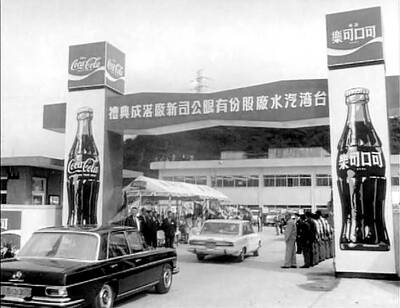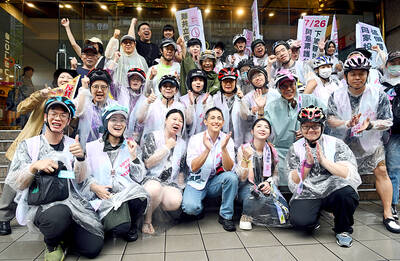VIEW THIS PAGE The National Center for Traditional Arts (國立傳統藝術中心), in Ilan County, bills itself as a “national window on our [Taiwanese] culture,” in its English-language brochure. It includes a major center for research on Taiwanese culture, for scholars who want to study the development of Taiwanese opera, wood block printing, and much else. For the rest of us, it offers an early-times Taiwan theme park that has proved remarkably effective in attracting domestic and foreign tourists.
The reason for the local interest became evident as I stood outside a ye olde grocery store — the tangerine shop (柑仔店) in Taiwanese — on the Center’s Folk Art Boulevard. Under the loggia, in front of the wood framed windows that looked into a shop displaying a bewildering array of colorful sweets and toys, was a wooden stake, its top end bundled in straw, with sticks of huge polystyrene candy apples sticking out from it. Next to it was an old-fashioned red pillar-box. An old couple walking by stopped by the pillar-box. “They used to have green ones too,” the old lady said, as the conversation moved off down memory lane. Amy Shih (石品玉), a staffer at a cable TV provider, emerged from the shop with a huge bag of lollies. “It’s all stuff we used to get as children,” she said, picking through her purchases with friends to the cries of “I remember that.” The collection included a cat-faced lollipop made from maltose, mints you can whistle through, and various candied fruits that she couldn’t name, but which brought back memories.
Inside, there was a huge display of sweets and toys, most of which once sold for only a few cents each. They are a little more expensive now, but are still a world away in cost and sophistication from the Xbox 360 and PlayStation 3. While many nearby shops sold costly art objects with a Taiwanese flavor, such as bowls carved from bamboo roots or exotic organic tea, it was the toys and sweets that drew the greatest squeals of delight.
Folk Art Boulevard provides many opportunities to reminisce, but few things bring back the flavor of childhood as effectively as food. Amid the many stalls dealing with traditional handicrafts, there were plenty offering old-fashioned foods not readily available anymore. These included handmade ginger lollies (薑糖), made of maltose and old ginger, and sugar shallot wraps (糖蔥卷), crispy pulled sugar served with coriander, and peanut powder wrapped in a pancake. The cheap plastic toys and brightly colored sweets at the ye olde grocery store aside, a strong environmental theme linked many of the stores on Folk Art Boulevard — whether it was traditional foods, wooden clogs or handmade soap — sparking a nostalgia for the simplicity and purity of traditional Taiwanese rural life.
A performance stage outside the Wenchang Temple (文昌廟) hosts a wide variety of folk performances, ranging from displays of martial arts to folk dancing, designed to reignite an interest in traditional performance arts. Considerable space was also given to a shop specializing in Pili puppets (霹靂布袋戲), probably the most successful modernization of traditional Taiwanese performance art, and there was also a gezai opera (歌仔戲) for children on a stage that backs onto the soothing spectacle of the center’s Inland Waterway, a large lake that allows visitors to get away from the bustle and noise of the main shopping and eating areas.
As I sat on a wooden bench wondering whether it had been a good idea to order a bowl of over-sized Luotung stuffed tapioca balls (羅東包心粉圓), a local specialty, I heard the plaintive cry of a nearby vendor: “Popcorn, pig’s blood, ice cream!” The theme park had definitely got the eclecticism of Taiwan right. Above the snack area where I was doing my best with the tapioca balls, is the Big Fisherman Guoyan Restaurant (大漁翁國宴美食主題館), which specializes in traditional Ilan cuisine [see the review on Page 15 of tomorrow’s Taipei Times].
For something more seriously cultural, it was necessary to go across to Scholar Huang’s Residence (黃舉人宅) on a grassy island that divides the Inland Waterway from the Dongshan River (冬山河). This house, which was relocated here stone by stone, is a wonderful example of a traditional domestic residence, but unfortunately, little has been done to give it the same appeal as the shops of Folk Art Boulevard. The exhibits inside are a bit drab, and in the spirit of the theme park, the courtyard just called out for some sort of teahouse to be set up there. Here was serious culture, but the commercial pop versions across the way seemed to be doing much better at bringing in the punters.
The Center’s Exhibition Hall, currently featuring an exhibition titled Nurtured in Tradition: Value-Added With Design (傳統文化藝術加值設計暨授權展), showed what is being done to commercialize Taiwanese culture in luxury designer goods. In the hushed space of the beautifully appointed museum, a small number of interesting designs were crowded out by gaudy and excessively crafted items. To my mind, they compared poorly in terms of interest to the cheap Transformer action figures and plastic whistles that cluttered the grocery store. The exhibition runs until April 19.
With its mix of high culture and kitsch, luxury items and cheap trash, of nostalgia for a rustic past and a reawakening of ambitions for an ecologically aware future, there is a lot going on at the National Center for Traditional Arts. The things on offer are certainly not unique, but the center has done a remarkable job in bringing them all together in an easily digestible package. VIEW THIS PAGE

July 28 to Aug. 3 Former president Chiang Kai-shek (蔣介石) reportedly maintained a simple diet and preferred to drink warm water — but one indulgence he enjoyed was a banned drink: Coca-Cola. Although a Coca-Cola plant was built in Taiwan in 1957, It was only allowed to sell to the US military and other American agencies. However, Chiang’s aides recall procuring the soft drink at US military exchange stores, and there’s also records of the Presidential Office ordering in bulk from Hong Kong. By the 1960s, it wasn’t difficult for those with means or connections to obtain Coca-Cola from the

Taiwan is today going to participate in a world-first experiment in democracy. Twenty-four Chinese Nationalist Party (KMT) lawmakers will face a recall vote, with the results determining if they keep their jobs. Some recalls look safe for the incumbents, other lawmakers appear heading for a fall and many could go either way. Predictions on the outcome vary widely, which is unsurprising — this is the first time worldwide a mass recall has ever been attempted at the national level. Even meteorologists are unclear what will happen. As this paper reported, the interactions between tropical storms Francisco and Com-May could lead to

A couple of weeks ago the parties aligned with the People’s Republic of China (PRC), the Chinese Nationalist Party (KMT) and the Taiwan People’s Party (TPP), voted in the legislature to eliminate the subsidy that enables Taiwan Power Co (Taipower) to keep up with its burgeoning debt, and instead pay for universal cash handouts worth NT$10,000. The subsidy would have been NT$100 billion, while the cash handout had a budget of NT$235 billion. The bill mandates that the cash payments must be completed by Oct. 31 of this year. The changes were part of the overall NT$545 billion budget approved

No one saw it coming. Everyone — including the Chinese Nationalist Party (KMT) — expected at least some of the recall campaigns against 24 of its lawmakers and Hsinchu Mayor Ann Kao (高虹安) to succeed. Underground gamblers reportedly expected between five and eight lawmakers to lose their jobs. All of this analysis made sense, but contained a fatal flaw. The record of the recall campaigns, the collapse of the KMT-led recalls, and polling data all pointed to enthusiastic high turnout in support of the recall campaigns, and that those against the recalls were unenthusiastic and far less likely to vote. That